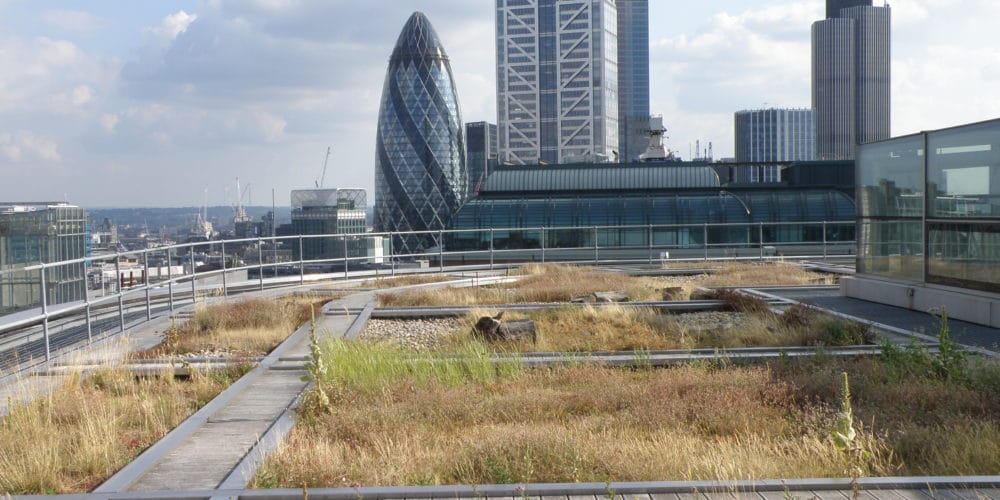
The alarming decline in wildlife, in Britain and world-wide, has been documented in numerous reports. A cornerstone of the government’s 25-year environment strategy is the need to halt and reverse this loss. Achieving sustainable development is a fundamental purpose of town & country planning, so the system has a major role to play in nature recovery. When the Environment Bill passes into law it will introduce a requirement to achieve biodiversity net gain in all developments through the planning process.
Green roofs have a huge potential to enhance biodiversity and bring many other environmental benefits at low cost. They are especially useful in dense urban areas, introducing very valuable habitats where there is currently little or no wildlife and where there is limited land for other measures such as tree planting.
The term ‘green roof’ may bring to mind elevated gardens with lush planting for the enjoyment of the buildings’ occupants. Such ‘intensive’ green roofs need deep soil, so are expensive, because the building needs to be structurally reinforced, and they are not particularly good for wildlife. A much cheaper and easier solution is the ‘extensive’ green roof. At its simplest, this is a layer of coarse material, such as crushed recycled demolition waste, laid over a waterproof membrane. It does not need to be thick, so the building does not have to be strengthened. This substrate mimics the poor soils that, in nature, support highly biodiverse wildflower meadows. When seeded with an appropriate grass and flower mix, such roofs provide a rich feeding habitat for pollinators such as bees and butterflies, as well as supporting a surprising variety of other invertebrates. The insects and seeds in turn provide a food source for birds.
The wildlife value of the roof can be enhanced by measures such as varying the depth and materials of the substrate, as well as incorporating features such as logs, all of which provide different ecological niches. Photovoltaic panels are not precluded from green roofs, and the shading they introduce creates yet more habitat variety. Extensive green roofs require little maintenance.
As well as their value for biodiversity, extensive green roofs bring many other benefits:
- They reduce flood risk by absorbing and transpiring rain water, significantly attenuating run-off. Green roofs can be a key component in sustainable drainage systems. In Switzerland, for example, where flooding has long been a problem, green roofs have been a standard planning requirement for many decades.
- Conventional flat roofs suffer damaging extremes of temperature, so typically need renewing after about 30 years. By maintaining the roof structure at an even temperature, a green roof can substantially increase its operational life.
- Similarly, a green roof acts as insulation, protecting the interior of the building from excessive heat and cold, so reducing energy used for heating and air conditioning.
- These savings mean a green roof need cost no more to install and maintain than a conventional roof.
- The extensive use of brick, stone and concrete in large towns leads to the absorption of sunlight, causing an urban ‘heat island’ effect, which will worsen in future with climate change. By transpiring water vapour from soil and plants, green roofs increase humidity, mitigating this effect.
- Green roofs absorb pollution, including dust and particulate matter, as well as noise.
- They can create recreational space for users of a building and make an attractive outlook from windows.
Green roofs are an environmental win-win, bringing a host of benefits, so we will see many more being installed in future.
Author: Derek Read
